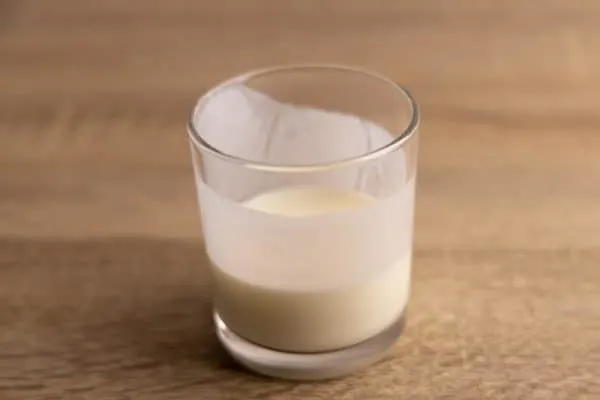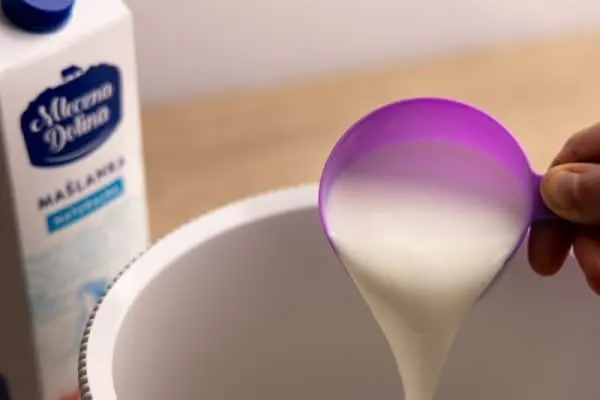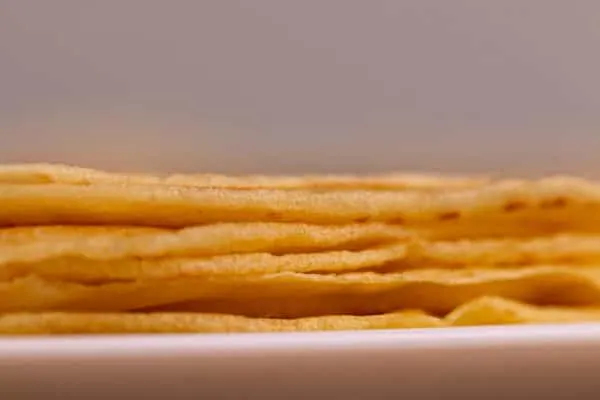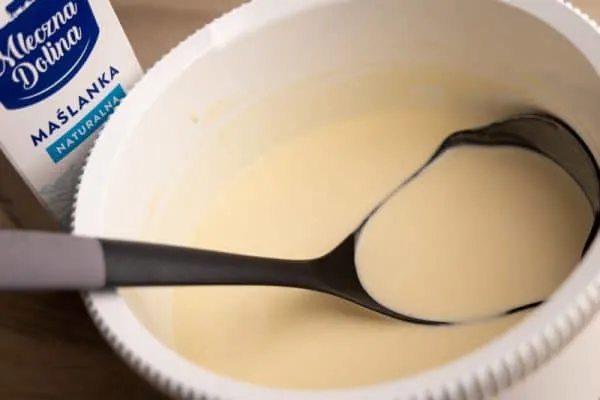Let’s talk about the shelf life, spoilage, and storage of buttermilk.
Say you’ve opened a buttermilk container for your pancakes, and you’re wondering how long does buttermilk last after opening.
Or maybe yours is a few days past the printed date, and you want to learn how to tell if buttermilk is bad.
Sounds familiar?
If so, this article is for you. Let’s jump right in.

Table of Contents
- How Long Does Buttermilk Last?
- How to Tell if Buttermilk Is Bad?
- Buttermilk Substitutes
- How to Store Buttermilk
- Can You Freeze Buttermilk?
- How To Freeze Buttermilk
- Buttermilk Shelf Life and Spoilage Summary
How Long Does Buttermilk Last?
Buttermilk lasts up to a week past the date printed on the label. Once you open the carton or jug, make sure it’s always sealed tight, and use the dairy product within two weeks. And if it’s already nearing its date, shorten that to a week.
If you can’t use the leftovers within that period, you can freeze them.
(More on freezing buttermilk below.)
Buttermilk has a shelf life of a couple of weeks, so it’s not one of those products you need to eat soon or discard. Admittedly, it doesn’t last nearly as long as butter, but the storage times both before and after opening are quite decent.
After Expiration
Each buttermilk container comes with a use-by date on the label, and it’s a reasonably good indicator of how long the product should keep quality.
Buttermilk typically keeps for only a couple of days, maybe up to a week, beyond the printed date. And it’s not a given that it will actually last the whole seven days beyond the printed date, so don’t wait until the last second to use it.
After Opening
Once you open the container, it’s best to use its contents within about a week to be safe. But in most cases, buttermilk should keep for up to two weeks of opening, assuming that you don’t open it only a few days before the printed date.
If your buttermilk is already quite old, i.e., within a couple of days of the use-by date, finish any leftovers within 3 to 7 days. And the sooner you do it, the better.

How to Tell if Buttermilk Is Bad?
Discard your buttermilk if:
- It smells off. Something is wrong if your buttermilk has taken on a sharp smell. And you probably don’t want to know what exactly. Toss it.
- It’s super sour. Buttermilk is supposed to be a bit acidic and tangy. But if it starts to give you sauerkraut or kimchi vibes, it’s gone.
- It stays thick after shaking. Buttermilk is slightly lumpy if it sits in the fridge for a while, but if it stays super thick after shaking, it’s gone. More on that below.
- It’s opened for more than two weeks. As mentioned, buttermilk can last for up to two weeks after opening, depending on when you open it. But if it’s opened for longer than that, discard it no matter what.
- It’s moldy. If you notice any mold or other discolorations after pouring it into a glass, toss it.
Those are the typical signs of spoilage for buttermilk. But if something else seems off, trust your gut and throw out the dairy product. Better safe than sorry.
Next, let’s take a minute to talk about sourness and lumps in buttermilk.
Does Buttermilk Smell Sour?
Yes, buttermilk is a fermented dairy product, and because of that, it should smell and taste slightly sour. The sourness should be fairly subtle, though not nearly as obvious as in sauerkraut or pickles.
If your buttermilk smells or tastes super sour, it’s a sure sign that it has gone bad, and you should toss it.
(Yeah, fermented dairy products can definitely go bad. That means your kefir isn’t impervious to spoilage, either.)
Should Buttermilk Be Chunky?
Yes, buttermilk is a bit chunky and thick. That’s why almost every jug or carton asks you to give it a vigorous shake before drinking. That breaks up the lumps and makes the dairy product easily pourable.
A couple of shakes is usually all you need to fix the texture. But if your bicep needs an extra workout, that’s as good a time as ever.

Buttermilk Substitutes
Say your buttermilk has gone bad, but you’d kill for a batch of delicious pancakes. So you’re looking for a substitute.
Kefir is probably the best buttermilk substitute, so if you’ve got some on hand, use it. Yogurt also works quite well, perhaps mixed with some milk if it’s too thick for your liking.
If you need some buttermilk for cooking or baking, there are at least two other options.
The first one is “clabbered” milk.
“Clabbered” milk is dairy milk with lemon juice added. The proportion is 1 tablespoon of lemon juice per 1 cup of milk, and that mix is what you use instead of the buttermilk. Adding the acidic substance to milk causes the proteins to coagulate and form clumps. Once done, it’s ready to be mixed into your batter immediately.
Clabbered milk won’t thicken as much as buttermilk does, so you might need to reduce the amount of clabbered milk you use in your recipe.
The other one is dry buttermilk powder.
If you don’t use buttermilk that often and usually need just half a cup for your pancakes, try using dry buttermilk powder instead. The powder lasts around a year, and you can store it at room temperature.

How to Store Buttermilk
Like pretty much all dairy products, say kefir or feta cheese, it needs to be in the refrigerator.
Speaking of which, the door is where the temperature changes the most, so if you can, keep the opened buttermilk in the far corner.
Once you open the container, remember to always keep it sealed tightly. And unless you’re going to finish the thing in one go, don’t drink straight from the bottle or carton.
Finally, don’t keep buttermilk on the counter while making pancakes (or what have you). Just pour as much as you need in a glass, and put the carton back in the fridge.
Can You Freeze Buttermilk?
If you’re buying buttermilk only for pancakes, and you often discard the leftovers, freezing is definitely worth trying out.
The first thing you should know is that most producers advise against freezing buttermilk. You can often see a “Do not freeze” label on the container.
That’s for a reason: frozen and thawed buttermilk changes in texture. Milk solids separate, and the whole thing is somewhat lumpy. That’s definitely a no-go if you plan on drinking the buttermilk as-is.
But if you’re using it in a cooked dish, like pancakes, that slightly altered texture doesn’t matter that much. You mix in a bunch of other ingredients anyway, so there should be little to no difference in how your delicious breakfast turns out.

How To Freeze Buttermilk
You can freeze buttermilk in a muffin tin. Here’s how to do it:
- Pour as much as you need for a single batch of pancakes into each cup.
- Put the tin into the freezer and leave it there until the liquid freezes.
- Transfer the frozen blocks into freezer bags, so they don’t take as much space.
If you don’t have a muffin tin, use a bunch of small freezer-safe containers or freezer bags.
Whenever you plan on making pancakes, just put a single block in the fridge the night before. It requires some planning ahead, but thawing in the refrigerator is definitely the best option. Plus you can refreeze the leftover buttermilk if need be.
Refrozen buttermilk will be even worse in terms of texture, so you should avoid it if you can help it.
If you have frozen buttermilk, but no time to thaw it, you can still make your pancakes if you can substitute the dairy product.

Buttermilk Shelf Life and Spoilage Summary
Thanks for reading this primer on buttermilk. Here are the takeaways:
- Buttermilk lasts for at least a few days past the printed date. After opening, it lasts for up to two weeks, depending on when you first open it.
- Discard your buttermilk if it stays super thick or lumpy even after a vigorous shake. Toss it if you notice any mold in it, it becomes super sour, or it’s open for more than 10 to 14 days.
- Keep your buttermilk refrigerated, and make sure you seal the bottle or carton tightly after every use. Don’t drink straight from the carton unless you’re going to finish the whole thing.